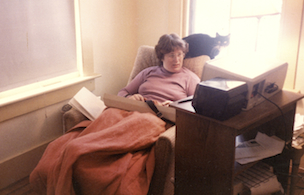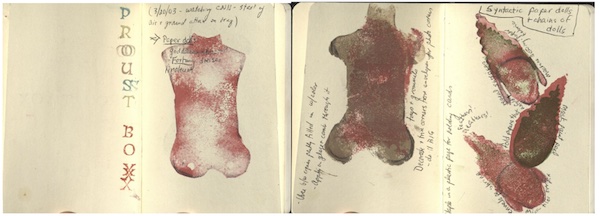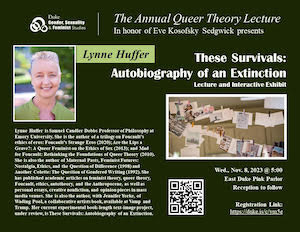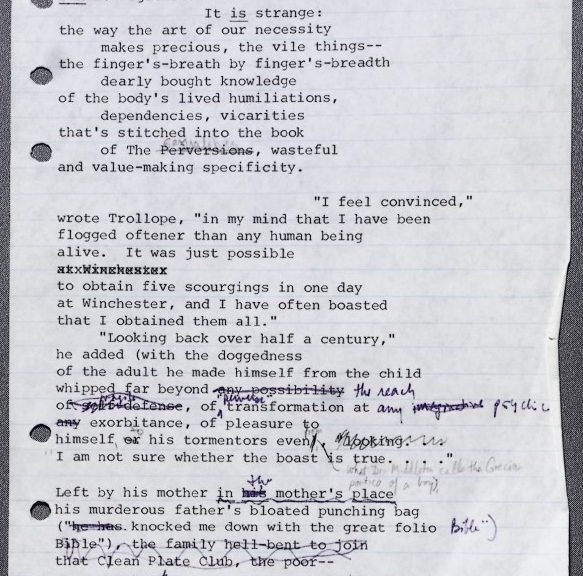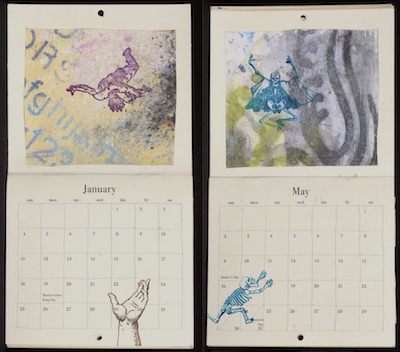BLOG
2024-2025 RECIPIENTS OF THE EVE KOSOFSKY SEDGWICK TRAVEL GRANT ANNOUNCED
Annual travel grants to support research using the Eve Kosofsky Sedgwick Papers at the Sallie Bingham Center at Duke University are funded by the Eve Kosofsky Sedgwick Foundation and administered through Duke University’s Rubinstein Rare Book & Manuscript Library. We congratulate this year’s grant recipients and look forward to their work.
The 2024-2025 grant recipients and project titles are:
Ipek Sahinler, Ph.D. candidate, University of Texas Austin, “A Portrait of Young Women as Proto-Queer Thinkers: Eve Sedgwick vis-à-vis Gloria Anzaldúa.”
David Seitz, Faculty, Harvey Mudd College, “‘No Less Realistic’ but with ‘Different Ambitions’: Reparative Reading, Human Geography, and a Return to Sedgwick.”
RELATED - GRANTS
MATILDE MANARA ON WORKING WITH THE SEDGWICK ARCHIVE AT DUKE
Image caption: Proust Box notebook with notes on paper dolls, hexaflexagons (first pages), Eve Kosofsky Sedgwick Papers, Box 40.
Matilde Manara, a Postdoctoral Fellow at Institut Lethica, Université de Strasbourg, France, is a 2023-2024 recipient of the Eve Kososfsky Sedgwick Travel Grant.
I approached the materials held in Eve Kosofsky Sedgwick’s Papers as part of a larger project on feminist models of writing, behavior, and knowledge to be found in Marcel Proust’s A la Recherche du Temps Perdu. I am particularly interested in understanding how readers can acknowledge a literary model such as A La Recherche, recognizing its importance in their life and/or art, without necessarily embracing its esthetic, moral, or epistemological foundations (and even by openly rejecting them). Along with Sedgwick’s Works in Fiber, Paper and Proust (2005), I delved into Chantal Akerman’s La Captive (2000), Jacqueline Rose’s Albertine (2001) and Anne Carson’s The Albertine Workout (2014). An important part of this research deals with questions raised by Sedgwick herself in her writings on Proust. In the final chapter of Epistemology of the Closet, she notably writes:
I was reading Proust for the first time during just the short stretch of years during which it occurred to me to have ambitions that were not exclusively under the aspect of eternity: to want to publish visibly, know people, make a go it, get a run for my money. Oddly, of course, it was reading Proust that made me want these adventures and think I could find them. The interminable meditation on the vanity of human wishes was a galvanizing failure for at least one reader: it was, if anything, the very sense of the transparency and predictability worldly ambitions that gave me the nerve and skill to have worldly ambitions of my own. Like, I believe, most young women, I never had a shred of identification with JuIien Sorel or the nineteenth-century French male plot of conquering the capital – until after the years of Proust-reading; then both the hero’s airy ambition and his concomitant uncritical adoption of a master text became intelligible and engaging traits (Sedgwick 1990, 241).
In preparing my visit to Duke, I had planned to explore this potential identification by dividing the materials I expected to consult into two categories: those related to Sedgwick’s academic work (syllabi from the seminars she held on Proust from around 1998 up to 2009, notes and drafts for Epistemology of the Closet and The Weather in Proust, scattered articles, and records of conferences) on the one hand, and those related to her artistic work (textile art, artists’ books, pieces from her 2005 exhibition, Works in Fiber, Paper and Proust) on the other. The days spent at Duke made me realize how much my plan was naive, even somewhat paradoxical, for these two practices are deeply intertwined and connected to each other in the same “fractal” way she suggests Proust’s novel should be read (Sedgwick 2011, 90-93).
I was most struck by two aspects of the materials I had the chance to consult in the archive. First, to see how Proust’s novel, in both its material dimension (the printed paper) and its virtual dimension (the hypertextual lattice we discover when not following a linear progression), becomes itself the object of a découture (witnessed by pages and pages of copied, printed and collaged quotations organized by Sedgwick under thematic headings such as Weather, Interior-outside, Albertine, Happiness, Anxiety, etc.), thus allowing the book’s complex architecture to emerge, while at the same time making it possible to detach from it, or even build it anew. Second, to observe how these shredded fragments feed into Sedgwick’s vast and increasingly central reflection on immanence (drawn on Proust as much as on Buddhism or the philosophy of Plotinus) to such an extent that the underlined pages of the many (including some multilingual) versions of A la recherche she uses over the years bear testimony to this gradual convergence, revealing how transformative reading the novel could have been for her.
My time at Rubenstein library has certainly given me the opportunity to enrich my project, helping me to better understand how Sedgwick reads, writes and seals in Proust – and not on, as she meant by the title of her exhibition at Harvard in 2005, “Works in Fiber, Paper, and Proust.” But it has also, and most importantly, touched me on a personal level, made my Proustian reader self fully and enthusiastically agree with her when she notices that:
It is harder to say in what this truth-effect of Proust consists. AII the paradoxes of a more traditionally conceived vraisemblance are especially active here: molecularly, there are relatively few individual propositions in or arising from the book that it would make sense to consider true; and even at the molar level, propositions or “values” or “attitudes” (erotic or political pessimism, for instance) that could be extracted from Proust do not necessarily seem true to me, to whom, nonetheless, “Proust” seems so “true”. Plainly, classically, it can be said that the coherence and credibility of the work, its vraisemblance in the usual senses, depend on an internal structuration of materials and codes that can only as relation, as structure, be interdigitated with or tested against the relational structures of a “reality” that surrounds and interleaves and thus mutually constitutes it. The truth-effect I am describing goes beyond questions of the work’s coherence and credibility, however. It has to do with the use of the literary work, its (to sound censorious) expropriability by its readers, its (to sound, in a different vocabulary, celebratory) potential for empowering them. For, unmistakably, the autobiographical parable I have just encapsulated as “the years of Proust-reading” represents both a prolonged instance of textual abuse and a story of empowerment. (Sedgwick 1990, 241).
RELATED - ARCHIVE
2023 DUKE QUEER THEORY LECTURE IN HONOR OF EVE KOSOFSKY SEDGWICK ANNOUNCED
The Annual Queer Theory Lecture in honor of Eve Kosofsky Sedgwick, presented by Duke Gender, Sexuality and Feminist Studies, will take place on Wednesday, November 8, 2023 at 5:00 pm ET. This year’s speaker is Dr. Lynne Huffer, whose talk is titled “These Survivals: Autobiography of an Extinction, Lecture and Interactive Exhibit.” Registration for both in-person and livestream attendance is available here.
Speaker Bio:
Lynne Huffer is Samuel Candler Dobbs Professor of Philosophy at Emory University. She is the author of a trilogy on Foucault’s ethics of eros: Foucault’s Strange Eros (2020); Are the Lips a Grave?: A Queer Feminist on the Ethics of Sex (2013); and Mad for Foucault: Rethinking the Foundations of Queer Theory (2010). She is also the author of Maternal Pasts, Feminist Futures: Nostalgia, Ethics, and the Question of Difference (1998) and Another Colette: The Question of Gendered Writing (1992). She has published academic articles on feminist theory, queer theory, Foucault, ethics, autotheory, and the Anthropocene, as well as personal essays, creative nonfiction, and opinion pieces in mass media venues. She is also the author, with Jennifer Yorke, of Wading Pool, a collaborative artists book, available at Vamp and Tramp. Her current experimental book-length text-image project, under review, is These Survivals: Autobiography of an Extinction.
RELATED - EVENTS
DUKE ARCHIVAL EXPEDITIONS FELLOW KATIE CARITHERS DEVELOPS EPISTEMOLOGY OF THE CLOSET COURSE MODULE
Image description: Edited typescript of Eve Kosofsky Sedgwick’s manuscript for “The Warm Decembers.”
Katie Carithers, a Spring 2023 Archival Expeditions fellow at Duke University, spent her fellowship working with the Eve Kosofsky Sedgwick Papers. As part of her fellowship, she designed a course module intended for introductory LGBTQ studies courses. Her module focuses on Sedgwick’s Epistemology of the Closet.
Of her module, Carithers writes:
The overall goal of the module is for students to use these archival materials to situate Sedgwick as a thinker within a cultural history. Through the selected archival materials, students will encounter Epistemology as thinking and writing that is in progress and in dialogue with other scholars and writers. And not just academic writing! There are zines, newspaper clippings, comics, and other written/visual artifacts. The aim is that, by close reading these materials, students will analyze how the taking up of sexuality as an analytic framework is tied to authorial and historical politics — and how that this is true for Sedgwick as well as scholars of LGBTQ studies today. I think that can help students reflect on the kind of questions they want to animate their own work and how they perceive their own writing in relation to their current moment.
A more extensive description of her work and process can be found at the Duke University website. More information about Duke’s Archival Expeditions program can be found here.
RELATED - ARCHIVE
METHODS FOR QUEERING INTERNATIONAL LAW
Odette Mazel, a PhD candidate at the Melbourne Law School, has published an article applying Sedgwick’s analysis of paranoid and reparative reading to international law. Appearing online in the current issue of the Australian Feminist Law Journal, “The Texture of ‘Lives Lived with Law:’ Methods for Queering International Law” offers a balanced interpretation of Sedgwick’s analysis. Mazel writes:
Queer theory’s obligations to critique and problematise the mechanisms of power and discourse, especially law, remain important for revealing, unsettling and destabilising established sexual and gender norms. However, as Eve Kosofsky Sedgwick argues, the emphasis on paranoid or critical practices in queer theorising must be counterbalanced by recognising the queer methods of repair evident in the way LGBTQIA+ people engage with systems of oppression in empowering and transformative ways. In this paper, I draw on the methodological tools that Sedgwick provides to examine LGBTQIA+ engagements with international law in terms of their creative, generative and sustaining capacities.
Referring to recent work exploring the concept of “legal materiality,” Mazel draws on Sedgwick’s artwork. Reproducing selected pages from Sedgwick’s 2004 calendar “Dropped Held,” Mazel writes:
The pictures accompanying each month in Sedgwick’s calendar of 2004 depict figures, animals and objects falling, but each dropping/falling is reciprocated with a depiction of holding/catching. These collaged images and stamped designs reflect to me the ethical queer orientation inherent in reading reparatively LGBTQIA+ efforts for legal reform. They express the vulnerability experienced in moments of suspension, the feeling of being in the tension, the space between repression and liberation. That there is dropping, but there is also holding.
